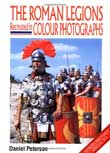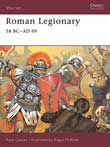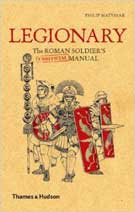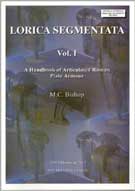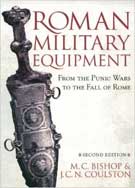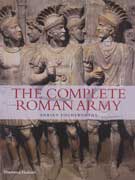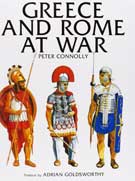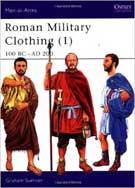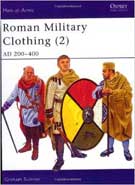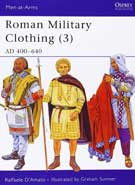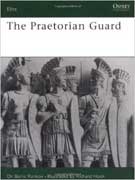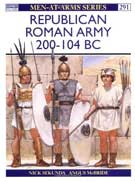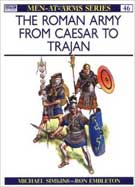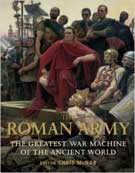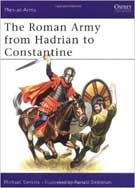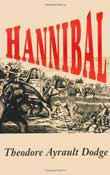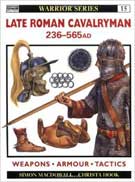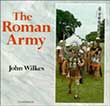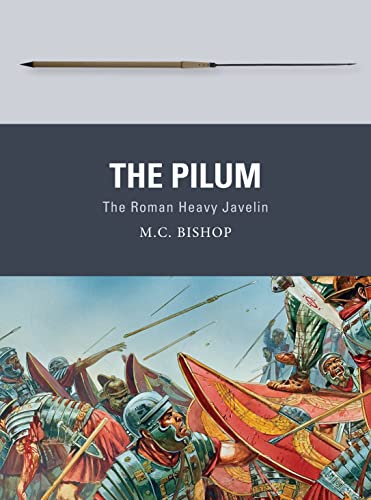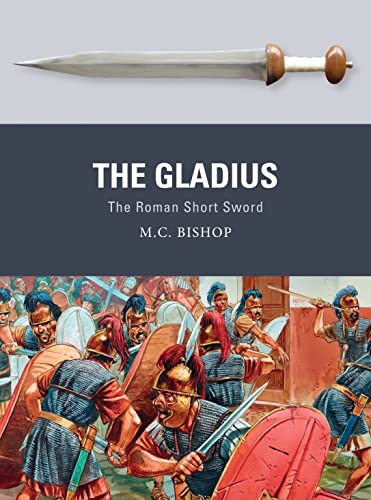

Imperial Roman,
Suggested Reading List
Rome, the true cradle of modern society and civilization. The Roman Legions reigned supreme for over a thousand years. As this is particular interest of mine, we have a lot of books here. If we've missed something, please let me know!
And yeah, the first part is "Osprey-heavy"... why? Because they serve a good purpose; not only to give one a good grounding in a subject, but also they have COLOR plates, which make things come alive. There are other books of course, and the first one I list is Dan Peterson's The Roman Legions Recreated in Colour Photographs. This book is SO excellent and it shows the kit in colour photographs -- that alone is worth it. Instead of looking at drawings or at best, colour paintings, you have real photos of people wearing and using this gear!
YOU HAVE TO BUY THIS BOOK FIRST!
It is, without a doubt, the best thing for the reenactor to get, as it shows full-color photos of Roman reenactors!
If the movie "Gladiator" shows Roman troops in all their glory on the big screen, "The Roman Legions: Recreated in Colour Photographs" captures all this glory in a book. The photos contained in this book are the marching Roman recreations you see on The Learning Channel, PBS, Discovery, and other educational TV shows. The author, Daniel Peterson, is a military historian and a museum curator and is also the organizer for the largest and most accurate recreations of the Roman military life. He's a member of the world's only authentically reconstructed Roman Calvary unit and in his personifying role has lived, marched, and ridden hundreds of miles across what was once the Roman Empire. His unit is authentically armored and equipped and prepares and eats authentic rations during their outings as Roman Legions. It goes without saying that his book is just as he envisioned it down to the last detail.
Suffice to say, the photos are absolutely stunning! There are hardly any drawings, paintings, or "historical art" in this book; that is all photos of Roman gear and equipment are real replicas and are worn by real humans. Front and back views are presented of Legionnaires, Calvary, Standard Bearers, Centurions, and auxiliary infantrymen. There are plenty of close-ups and detail shots of daggers, helmets, chain main, link plate, shields, and siege engines. Best of all, there are photos showing Legions marching, in formation, defending, and setting up defenses. There are no enemy actors in the photos so someone looking of battle scenes or how Rome's enemies look like will have to use other books.
This book has a brief history of the Roman Empire and also shows gear worn by early (BC) and later (300AD) Romans troops. However, the main focus of this book is showing Roman soldiers at the height of the Roman Empire: 1AD-200AD, or the traditional Legionary and Centurion with the red tunic and chrome plate body armor we often remember.
BUY THIS BOOK SECOND!
What I like about htis book, is that it tell sabout the soldier's LIFE, not just battles or his kit. The puffy people will look down their noses at Osprey books, but I tend to like them for the reenactor. Sure, you can buy books with more detail, but to start, to get a feel for the book, you need this! Buy it, you won't go wrong.
Publisher's description: The period 31 BC-AD 43 saw the greatest expansion of the Roman Empire. In 31 BC Octavian defeated Antony at the battle of Actium and remodelled the semi-professional Roman army into a permanent force of 28 legions. Octavian became the first emperor (Augustus) and under his leadership the legions conquered northern Spain, all Europe south of the Danube line and Germany west of the Elbe. The legionaries exemplified the heroic culture of the Roman world and this title takes a behind-the-scenes look at their lives, training, weaponry and tactics, including the bloody massacre of the Teutoberg forest.
A great book that puts the information there in an easy to understand, yet humerous manner. Is it deep? No. Is it supposed to be? No. This book DOES, however, impart some really good knowledge about the Legions and their soldiers. And it really is, kind of like a soldier's handbook.
Publisher's description: This carefully researched yet entertainingly unacademic book tells you how to join the Roman legions, the best places to serve, and how to keep your armor from getting rusty. Learn to march under the eagles of Rome, from training, campaigns, and battle to the glory of a Roman Triumph and retirement with a pension plan.
Every aspect of army life is discussed, from drill to diet, with handy tips on topics such as how to select the best boots, or how to avoid being skewered by enemy spears. 15 color, 25 b&w illustrations
THE book to get on the Lorica Segmentata. Well worht it and although pricey, it will help you if you are trying to build a set of this armor.
Publisher's description: This monograph is the first in-depth examination of articulated Roman plate armour since H. Russell Robinson published his ground breaking reconstructions of lorica segmentata in The Armour of Imperial Rome (1975). The book contains a detailed discussion of all the significant evidence including previously unpublished material. Bishop looks at each of the principle types of articulated plate armour, using photographs and drawings of original finds alongside full-sized and specially-prepared computer-generated reconstructions. He examines the strengths and weaknesses of this form of armour, considering a wide range of technical details, as well as practical aspects relating to its reproduction. An accompanying website will provide additional multimedia resources, including colour photographs of original and reconstructed segmental armour, 3D models, video clips, plans, and card models. (100 b/w figures).
Rome's rise to empire is often said to have owed much to the efficiency and military skill of her armies and their technological superiority over barbarian enemies. But just how 'advanced' was Roman military equipment? What were its origins and how did it evolve? The authors of this book have gathered a wealth of evidence from all over the Roman Empire—excavated examples as well as pictorial and documentary sources—to present a picture of what range of equipment would be available at any given time, what it would look like and how it would function. They examine how certain pieces were adopted from Rome's enemies and adapted to particular conditions of warfare prevailing in different parts of the Empire. They also investigate in detail the technology of military equipment and the means by which it was produced, and discuss wider questions such as the status of the soldier in Roman society. Both the specially prepared illustrations and the text have been completely revised for the second edition of this detailed and authoritative handbook, bringing it up to date with the very latest research. It illustrates each element in the equipment of the Roman soldier, from his helmet to his boots, his insignia, his tools and his weapons. This book will appeal to archaeologists, ancient and military historians as well as the generally informed and inquisitive reader.
The Roman army was one of the most successful fighting forces in history. Its organization and tactics were highly advanced and were unequaled until the modern era. Spectacular monuments to its perseverance and engineering skill are still visible today, most notably Hadrian’s Wall and the siegeworks around the fortress of Masada.This book is the first to examine in detail not just the early imperial army but also the citizens’ militia of the Republic and the army of the later Empire. The unprecedented scope and longevity of Roman military success is placed in the context of ordinary soldiers’ daily lives, whether spent in the quiet routine of a peaceful garrison or in arduous campaign and violent combat. Key battles and tactics are described, and there are brief biographies of the great commanders.Drawing on archaeology, ancient art, and original documentary sources, this book presents the most convincing history ever published of the Roman army. 107 full-color and 147 black-and-white illustrations
One of the "Standards" in studying the Greeks and Romans. Really great illustrations and even photos of the battlefields in the present day. Worth every penny!
Publisher's description: In this sumptuous guide to twelve centuries of military development, the late Peter Connolly combines a detailed account of the arms and armies of Greece and Rome with his superb full-color artwork. Making use of fresh archeological evidence and new material on the manufacture and use of the weapons of the period, the author presents an attractive and impressive volume that is both scholarly and beautifully presented with illustrations that are, quite rightly, recognized as being the best and most accurate representation of how the soldiers from these formidable military empires appeared.Greece and Rome at War lucidly demonstrates the face of battle in the ancient world. Covering the wars between the Greeks and the Persians and the epic contest between the Romans and their most capable opponent, Hannibal, as well as organization, tactics, armor and weapons, and much more, this excellent work brings the armies of Greece, Macedon and Rome vividly to life. This new revised edition contains a Preface by Adrian Goldsworthy.
A great book that gives a lot of information on a subject that isn't often covered. Well worth bying!
Publisher's description: The armour and weapons of Rome's legionaries and auxiliaries have been the subject of intense research and speculation, and much has been published - but almost nothing on the actual clothing of Imperial soldiers. In this first part of a rigorous study of the literary, sculptural, pictorial and archaeological evidence, a specialist author/artist examines the clues which enable us to attempt reconstructions of tunics, cloaks, footwear and other items worn by officers and men all over the empire, from the late Republic to c.200 AD. His text is illustrated with meticulous drawings of surviving relief sculptures - particularly soldiers' gravestones - and eight striking colour plates.
A great book that gives a lot of information on a subject that isn't often covered. Well worth bying!
Publisher's description: The armour and weapons of the Roman army have long been the subject of intense research and speculation. While much has been published on their arms and armour, however, the actual clothing of Imperial soldiers has largely been overlooked. In this second part of a rigorous study of the literary, sculptural, pictorial and archaeological evidence, the specialist author-artist examines the clues which enable us to attempt reconstructions of items worn by officers and men all over the empire during the two centuries between the reign of Septimius Severus and the twilight years of Stilicho.
Late Roman. A good primer on this time period's clothing.
Publisher's description: The early Romans were only one of a number of peoples that inhabited Iron Age central Italy. From the 8th to the 3rd century BC, the Romans undertook territorial expansion, and conflict with neighbouring tribes and cultures resulted in open war, most notably with the Samnites. Alliances sprang were created too - but the rise of Rome was unstoppable. This title covers the equipment, weaponry and dress of the early Romans, from the traditional foundation in 753 BC to the third century BC, where the dominance of Rome was beyond challenge. It also deals with developments in warfare, covering the early cavalry, the pre-hoplite army, the hoplite army and the manipular army. Etruscan, Latin, and Samnite warfare are also discussed.
The Praetorian Guard of Imperial Rome was the power behind the throne, with the ability to make or break an Emperor. Its origins lay in the guards units of republican commanders and the units of Octavian and Anthony that fought at Actium. This title covers the organisation, dress and history from these early days to the Guard's effective destruction at the battle of Milvian Bridge in AD 312, and also details the guard units of the third and fourth centuries that replaced those lost.
The principal source of information on the Roman Republican Army is the sixth book of the Histories of the Greek historian Polybius, written a little before 150BC. This engaging text by Nicholas Sekunda draws heavily on this vital source to outline the equipment and organisation of the Roman Republican Army from 200–104 BC -- a time when Rome was growing from a regional to a world power. With plenty of photographs and illustrations, including eight vivid full page colour plates by Angus McBride, this fascinating volume examines such topics as the Roman shield, helmets, the cuirass, greaves, the pilum, legion organisation, the principales and the tactics they employed.
Although the common Roman fighting men themselves have left no account, much literature has survived from antiquity. The wealth of archaeological finds, plus the study of surviving Roman scultpure has allowed hisorians to learn much about the nature of the Roman army which conquered an astonishing expanse of territory. Michael Simkins brings all his substantial knowledge to bear on this fascinating subject, covering such topics as army composition, recruitment, training, campaign routine and providing a wealth of detail on weapons, uniforms and equipment. Men-at-Arms 283, 291 and 46 are also available in a single volume special edition as 'Caesar's Legions.'
The image of the Roman legionary is as familiar today as it was to the citizens - and enemies - of the vast Roman Empire two thousand years ago. This book goes beyond the stereotypes found in popular culture to examine the Roman Army from the first armed citizens of the early Republic through the glorious heights of the Imperial legions to the shameful defeats inflicted upon the late Roman Army by the Goths and Huns. Tracing the development of tactics, equipment and training, this work provides a detailed insight into the military force that enable Rome to become the greatest empire the world has ever seen.As well as describing the changes in the army over the centuries, The Roman Army also sheds light on the talented men who led these soldiers in battle and the momentous battles fought, including Cannae, Pharsalus, and Adrianople. Illustrated with detailed maps, artwork and photographs, this volume provides a complete reference to the Roman Army from the 8th century BC to the period after the fall of the Western Roman Empire in the 5th century AD.
*An older book, but still a good addition to one's library.
Publisher's description: This book is also available with a different cover as "Legions of the North." The year of 122 was the first time a Roman Emperor had set foot in the Province of Britannia since the invasion in AD 43. No doubt he had read many reports concerning the damage caused by marauding tribesmen crossing from what is now Scotland into the Province. Hadrian, therefore, decided - in the words of his biographer - 'to build a wall to separate the Romans from the Barbarians'. This engaging work from author Michael Simkins explores in depth the organisation, equipment, weapons and armour of the Roman Army from Hadrian to Constantine, one of the most exciting periods in Roman history.
Hannibal is often considered the finest general the world has ever known. Setting out from Carthaginian-dominated Spain with a small army of select troops, he fought his way over the Pyrenees and crossed the Alps with elephants and a full baggage train. Descending into Italy, he destroyed the main Roman army at Lake Trasimeno and came close to conquering Rome itself. At Cannae, Hannibal's brilliant cavalry tactics enabled him to cut to pieces a reassembled Roman army, and his subsequent defeats over a fifteen-year stay in Italy were due more to lack of sufficient support from home than to any failings of generalship.T. A. Dodge's classic history, first published in 1891, is equally perceptive of Hannibal's military prowess and his visionary character. Dodge followed Hannibal's route from Carthage to Italy, paying particular attention to the famous crossing of the Alps, exploring every pass in order to determine Hannibal's route. In this book, he wrote an entire history of the art of war among these two mighty armies and included hundreds of invaluable illustrations. Hannibal remains unequaled as the most comprehensive and readable study of history's greatest general.
The twilight of the Roman Empire saw a revolution in the way war was waged. The drilled infantryman, who had been the mainstay of Mediterranean armies since the days of the Greek hoplite, was gradually replaced by the mounted warrior. This change did not take place overnight, and in the 3rd and 4th centuries the role of the cavalryman was primarily to support the infantry. However, by the time of the 6th century, the situation had been completely reversed. Late Roman Cavalryman gives a full account of the changing experience of the mounted soldiers who defended Rome's withering western empire.
A clear explanation of the organization and structure of the imperial army of about 100 A.D. describes the life of a professional soldier of the Roman Empire, including a typical battle.
Review form Amazon: Though this book is pretty dated, this text is still very accurate in its information. It focuses primarily on the Roman Army under Traianus (Trajan, 98-117) and Hadrianus (Hadrian, 117-138), but makes mention of soldiers and tactics from the 1st-4th Centuries AD. It is a pretty short book, and doesn't waste a lot of time on jargon. It does not really make an attempt to entertain the reader, but at the same time is not dull to read (I read it in less than an hour).
The author summarizes the equipment and recruitment of the legionaries and the auxiliaries, and also takes a useful look at Roman artillery. Included are a useful chart showing the command organization of a legion, and maps showing the main recruitment areas for the 2nd Century Empire. There are a number of black and white photos as well as some interesting and well-done line illustrations of the troops, and the front and back covers both show reenactors of the Ermine Street Guard.
Overall, I would reccomend this book for either a young reader (maybe about 8-14) or an older person who is just now getting their feet wet in the study of the Roman Army. For you veterans of Roman military history, however, this book probably doesn't have anything new for you.
An excellent book by noted Roman expert, Mike Bishop. No Roman library should be without this book! If Mike Bishop writes it, you can be sure that there is some really good info in there. And, about the Roman Pilum, a scare subject for a book to be based on. Exciting to see this most important weapon showcased.
A heavy javelin, normally used as a shock weapon immediately before contact, the pilum was designed with a particular specialty: it could penetrate a shield and carry on into the individual behind it. Relying on mass rather than velocity, at short range a volley of pila had much the same effect on a charging enemy as musketry would in later periods. The design was not uniform, with a wide diversity of types throughout the developmental history of the weapon, but for more than four centuries it remained a vital part of the arsenal of weapons at the disposal of the Roman legionary.
Drawing upon recent major finds in the Iberian Peninsula and the Balkans, as well as written records and rigorous scientific analysis, this enthralling study lifts the veil on the evolving nature of the pilum, the Roman heavy javelin that helped to conquer the known world.
An excellent book by noted Roman expert, Mike Bishop. No Roman library should be without this book! If Mike Bishop writes it, you can be sure that there is some really good info in there.
One of the most feared weapons in the ancient world, the gladius was lethal both on the battlefield and in the arena. Literary sources tell of the terror it inspired, while archaeological evidence of wounds inflicted is testament to its deadly effect. By pulling together strands of literary, sculptural, and archaeological evidence, renowned expert M.C. Bishop creates a narrative of the gladius' development, exploring the way in which the shape of the short sword changed as soldiers and gladiators evolved their fighting style.
Drawing together historical accounts, excavated artifacts, and the results of the latest scientific analyses of the blades, this volume reveals the development, technology, training and use of the gladius hispaniensis: the sword that conquered the Mediterranean.
Theodosius installed as co-Emperor of East Roman Empire
Pope Benedictus VI elected
French city of Rouen surrenders to Henry V in Hundred Years War
King Louis XIV and Emperor Leopold I sign treaty dividing Spain
Richard Steele publishes "Crisis, " defending Hanoverian success
Battle of Golden Hill (Lower Manhattan)
French King Louis XVI sentenced to death
Democratic revolution in Amsterdam ends oligarchy
Britain occupies Cape of Good Hope
Louis Napoleon signs 1st Dutch aviation law
Ezra Daggett and nephew Thomas Kensett patent food storage in tin cans
Charles Darwin reaches Straits Ponsonby, Fireland
Aden conquered by British East India Company
Antarctica discovered, Charles Wilkes expedition (US claim)
Georgia becomes 5th state to secede
MS troops take Ft Massachusetts an Ship Island
General Mieroslawski appointed Dictator of Poland
NV Suriname Bank established
Union occupies Fort Anderson, North Carolina
1st Negro lodge of US Masons approved, New Jersey
Battle at Abu Klea Sudan: 800-1000 killed
Aurora Ski Club, 1st in US, founded in Minnesota
Brown defeats Harvard 6-0 in 1st intercollegiate hockey game
Anglo-Egyptian Sudan forms
1st regular transatlantic radio broadcast between US and England
New bicycle race "Tour de France" announced
Germany and Bolivia ends commerce / friendship treaty
National Institute of Arts & Letters incorporated by Congress
1st German Zeppelin attack over Great Britain, 4 die
Neon Tube sign patented by George Claude
Soviets disallows a Constitution Assembly
"Tidal wave" of molasses 15 m high x 25 m wide kills dozens, Boston
Alexandre Millerand forms French government
US Senate votes against membership in League of Nations
Costa Rica, Guatemala, Honduras and El Salvador sign Pact of Union
Geological survey says US oil supply would be depleted in 20 years
WMC-AM in Memphis TN begins radio transmissions
British government decides to send troops to China
Acadia National Park, Maine established
Clas Thunberg skates world record 500m in 42.8 sec
Charlie Conacher becomes 1st Toronto Maple Leaf to score 5 goals in a game, 1st coming at 7 seconds of game
KLM begins flight path between Curacao and Aruba
Cy Young, Tris Speaker and Nap Lajorie elected to Baseball Hall of Fame
Millionaire Howard Hughes sets transcontinental air record (7h28m25s)
GM began mass production of diesel engines
Ernest Hausen of Wisconsin sets chicken-plucking record-4.4 sec
British offensive in Eritrea
British troops occupies Kassalaf Sudan
Japanese forces invade Burma
Titus Brandsma arrested by German occupiers
Joint Chiefs of Staff decide on invasion in Sicily
SS Himera runs aground at Athens, kills 392
NFL takes control of New York Yanks
PGA approves allowing black participants
Jesse Owens named Illinois Athletic Commission secretary
"Millionaire" TV program premieres on CBS
"Scrabble" debuts on board game market
1st presidential news conference filmed for TV (Eisenhower)
Hoboken dedicates a plaque honoring achievements of Alexander Cartwright in organizing early baseball at Elysian Field
Canadian Football Council renamed Canadian Football League
Eisenhower and Premier Kishi sign US-Japanese Security pact
1st episode for "Dick Van Dyke Show" is filmed
AFL Pro Bowl: West beats East 27-24
KFME TV channel 13 in Fargo, ND (PBS) begins broadcasting
Tippetts cantate "Vision of St. Augustine, " premieres in London
Herr Karl Tausch writes shortest will "Vse Zene" (All to wife)
WKBF TV channel 61 in Cleveland, OH (IND) begins broadcasting
AFL Pro Bowl: West beats East 38-25
NFL Pro Bowl: West beats East 10-7
Dutch bishops says he is in favor of married priest
Nixon nominates G Harold Carswell to Supreme Court (fails)
UCLA fires Angela Davis for being a communist
"No, No Nanette" opens at 46th St. Theater NYC for 861 performances
24th NHL All-Star Game: West beat East 2-1 at Boston
Sandy Koufax, Yogi Berra, and Early Wynn elected to Hall of Fame
Belgium government of Leburton falls
Notre Dame beats UCLA, ends NCAA-record 88-game basketball win streak
4 mail truck assault on El Al B-747 in Paris, escape to Iraq
Kathy Whitworth wins LPGA Colgate Golf Triple Crown
Ernie Banks elected to Hall of Fame
Eddie Mathews elected to Hall of Fame
Judge William H Webster appointed head of FBI
John N Mitchell (former AG) released on parole from federal prison
Muhammad Ali talks a despondent 21 year old out of committing suicide
US and Iran sign agreement to release 52 American hostages
Aust-WI one-day game that produced a Privy Council libel case
Heater explodes at Star Elementary School-Okla, kills 6 kids and teacher
Klaus Barbie, SS chief of Lyon in Nazi-France, arrested in Bolivia
California Supreme Court rejects quadriplegic Elizabeth Bouvia, who wants to starve herself to death in a public hospital
Francesco Moser bicycles world record time: 50,808 km
"Born In The USA" by Bruce Springsteen peaked at #9
4 die in a car and train crash in Buda, Illinois
Israeli Premier Simon Peres visits Netherlands
Spain recognizes Israel
"48 Hours" premiers on CBS-TV
President Reagan pardons George Steinbrenner for illegal funds for Nixon
Test debut of Mushtaq Ahmed, vs. Australia at Adelaide
42nd NHL All-Star Game: Campbell beat Wales 11-5 at Chicago
48th Golden Globes: Dances with Wolves
Eastern Airlines shuts down operation
Jumbo Tsuruta beats Stan Hansen to win All Japan Triple Crown title
Sgt Slaughter defeats Ultimate Warrior for WWF championship belt
"City of Angels" closes at Virginia Theater NYC after 878 performances
Cerebral Palsy telethon raises $23,500,000
IBM announces a nearly $5B loss for 1992
Nature Boy Ric Flair becomes WWF champ at Royal Rumble
Rowdy Roddy Piper beats Mountie to become WWF Intercontinental Champ
Israel recognizes PLO as no longer criminal
Oakland Athletics unveil new elephant logo
Robert M Gates, ends term as 15th Director of CIA
STS-54 (Endeavour) lands
Jean-Claude Juncker (28) sworn in as Premier of Luxembourg
NHL approves move of Winnipeg Jets to Phoenix
54th Golden Globes: English Patient, Brenda Blethyn and Geoffrey Rush
Michelle McGann wins LPGA Healthsouth Inaugural
